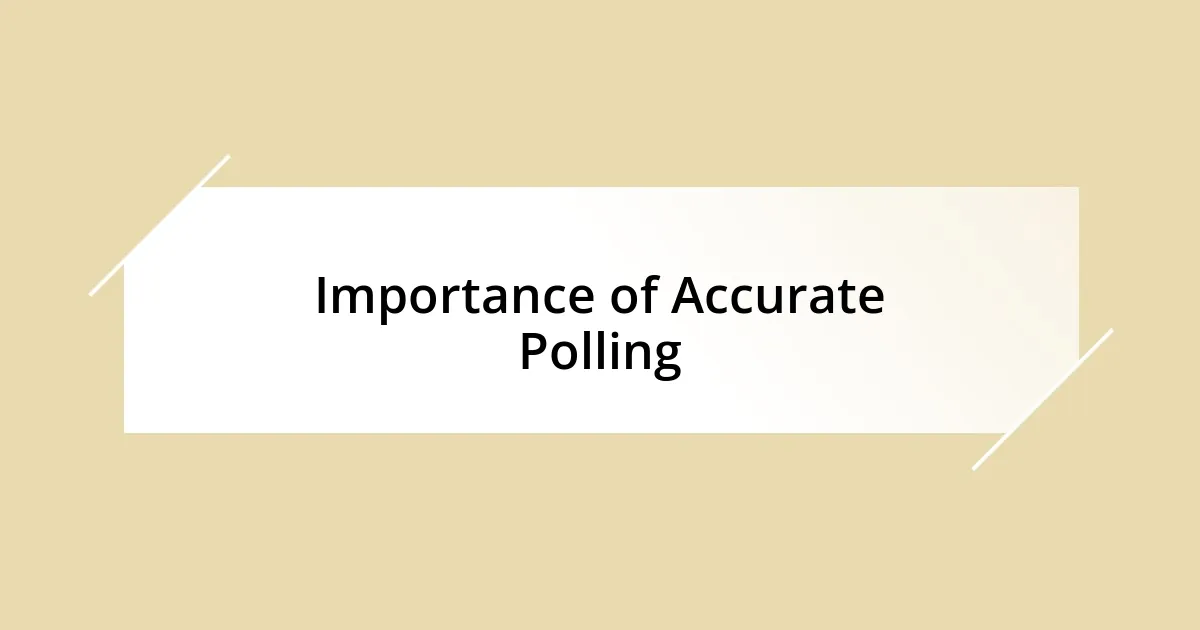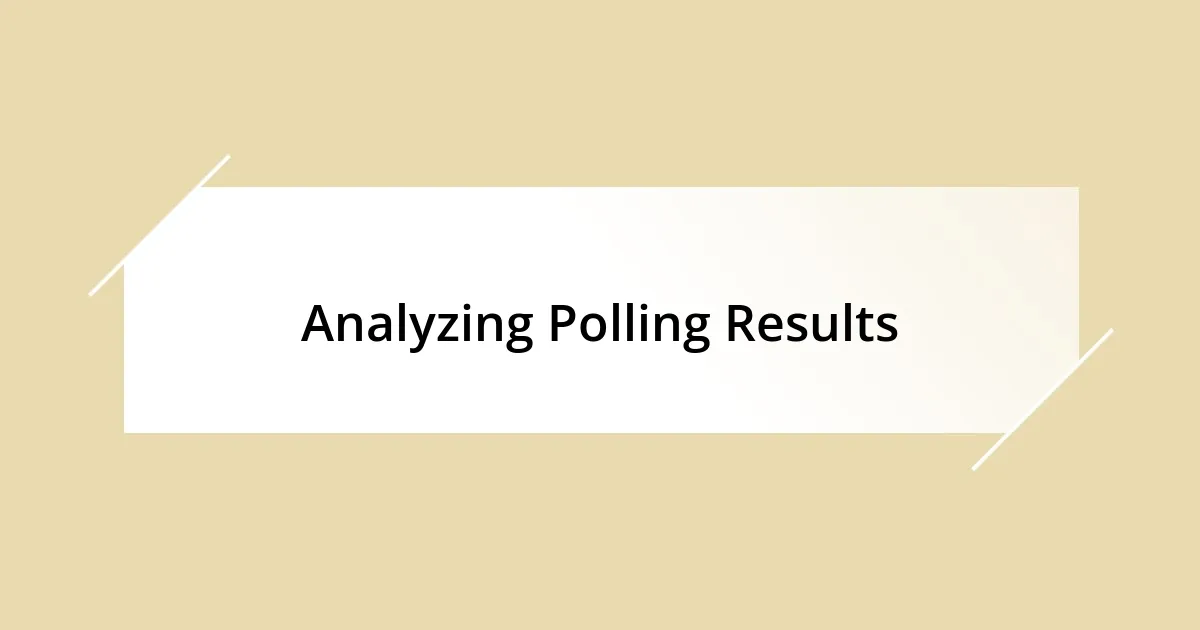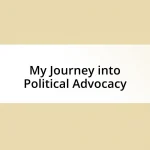Key takeaways:
- Different polling methods, such as telephone, online, focus groups, and exit polls, each have unique advantages and can impact the accuracy of public sentiment representation.
- Accurate polling is essential for informed decision-making, accountability, and civic engagement; inaccuracies can mislead voters and policy priorities.
- Best practices in polling include ensuring representative samples, crafting unbiased questions, and maintaining transparency in methodologies to enhance credibility and trust.

Overview of Political Polling Methods
Political polling methods can drastically differ, influencing the outcomes we see during elections. From my observations, traditional methods like telephone interviews often feel more personal and may yield candid responses. Have you ever noticed how people can be more open when they think they’re talking to a real person instead of a computer?
Another popular technique is online polling, which has become increasingly widespread. It’s fascinating how this method taps into a broader audience, yet it raises some concerns. I’ve had moments where I questioned if the diversity of respondents online truly mirrors the general population. It gets me thinking: are we missing the voices of those who aren’t tech-savvy or who might feel intimidated by digital platforms?
Focus groups add another dimension to polling that I find particularly insightful. In these sessions, I appreciate observing the dynamic interactions as individuals share perspectives. It’s not just about numbers; it’s about the emotions and stories behind them. Have you ever joined such a discussion? I remember participating in one, and it illuminated how nuanced voter opinions can be, revealing layers that mere surveys can overlook.

Importance of Accurate Polling
Accurate polling plays a crucial role in shaping public discourse and informing decisions. I recall a time when a poll showed overwhelming support for a local initiative, only for the reality on election day to tell a different story. This discrepancy highlighted how misleading polling can not only misinform voters but also skew the priorities of policymakers. It’s alarming to think about how such inaccuracies can lead to misguided legislation that affects many lives.
When polls are wrong, the fallout can be significant. I once witnessed a candidate adjust their strategy based on a misleading poll, ultimately wasting resources and opportunities. Accurate polling helps to hold political figures accountable and ensures they respond to the genuine needs of their constituents. I believe it’s vital to have polls that reflect the true sentiments of the people, as they provide the necessary feedback loop for democracy to function effectively.
Ultimately, the importance of getting polling right cannot be overstated. A transparent and accurate representation of public opinion allows for healthier political discussions and better-informed citizens. I’ve found that when people see polling as reflective of their real opinions, they feel more engaged and empowered in the democratic process. Isn’t it crucial for our voices to be heard clearly in the cacophony of political noise?
| Impact of Accurate Polling | Impact of Inaccurate Polling |
|---|---|
| Enhances informed decision-making | Leads to misguided choices |
| Promotes accountability among politicians | Can waste resources and time |
| Encourages civic engagement | Can create disillusionment among voters |

Types of Political Polling
The landscape of political polling encompasses various methods, each with its distinct advantages and drawbacks. I often think back to my first experience with exit polls on election day. Standing outside a polling station, I was intrigued by how those brief conversations could offer instant insights into voter sentiments. Exit polling captures the immediate reactions of citizens right as they leave the voting booth, making it a compelling way to gauge public opinion.
Here’s a quick look at the primary types of political polling:
- Telephone Polling: Traditional method offering personal interaction, often yielding more candid responses.
- Online Polling: Quick and accessible but risks excluding less tech-savvy demographics.
- Focus Groups: In-depth discussions that reveal the complexities behind voter preferences.
- Exit Polls: Conducted after voting, providing immediate feedback on public opinion and voter intentions.
Each polling method brings something unique to the table. I recall a particularly memorable focus group where participants engaged passionately, sharing stories that numbers alone couldn’t convey. It reminded me that, at the core of polling, we’re not just collecting data; we’re capturing the human experience behind those responses.

Data Collection Techniques
Collecting data in political polling requires a variety of techniques tailored to the target population. One of the methods I’ve found most effective is telephone polling, which allows for a conversational approach. I remember participating in a survey myself, where the interviewer not only asked questions but also engaged me in a meaningful dialogue about the issues. It felt personal and allowed my genuine opinions to shine through. Doesn’t it make sense that a conversation can unveil nuances that a simple checkbox might overlook?
Online polling has gained traction due to its convenience, appealing to a tech-savvy audience. I once took part in an online political survey, and while it was fast and easy, I wondered how many people who might lack internet access or aren’t comfortable with technology were left out. This raises an important question: are we sacrificing inclusivity for speed? Balancing these modern techniques with traditional methods can greatly enhance the effectiveness of poll data, ensuring we capture a wider array of voices.
Focus groups offer an intriguing layer of depth to data collection. I had the opportunity to facilitate a focus group where participants opened up about their voting motivations, often revealing emotional stories that statistics simply couldn’t convey. This experience confirmed for me that understanding the “why” behind voter behavior is just as crucial as knowing the “what.” Isn’t it fascinating how much richer our understanding can become when we listen to personal narratives rather than solely relying on numbers?

Analyzing Polling Results
When analyzing polling results, it’s essential to look beyond the numbers to understand the context and implications behind them. I remember poring over polling data during a particularly heated election season, trying to make sense of fluctuating support for candidates. It struck me how cultural events or social media trends could dramatically shift public opinion overnight. Isn’t it amazing how quickly perceptions can evolve?
I also find it crucial to consider the demographics and methodology behind the polls. For instance, I participated in a focus group that aimed to gauge younger voters’ preferences. Listening to my peers articulate their stances, I realized that age, education, and even geography can dramatically affect how people respond. Analyzing the results without considering these factors can lead to misconceptions about what the data truly represents.
Moreover, when interpreting polling data, I often ask myself who funded the research and why. I once encountered a poll commissioned by a political party that seemed to favor their agenda. This experience prompted me to dig deeper, questioning how biases might inform the results. Are we, as consumers of this information, critically evaluating the sources, or are we just accepting the numbers at face value? Understanding these nuances can illuminate the dialogue around any election cycle.

Common Polling Challenges
Political polling faces several challenges, and one major hurdle is the issue of nonresponse bias. In my experience, I’ve seen surveys where a significant portion of people simply don’t respond. This often leads to a skewed representation of the population. Have you ever thought about how this could affect the outcomes? It’s particularly concerning when the demographics of respondents differ drastically from the broader electorate.
Another dilemma is the difficulty in accurately capturing the sentiments of undecided voters. I vividly remember a local election where I spoke with friends who were unsure whom to support. Their hesitations were influenced by numerous factors, from social pressures to misinformation. So, how do you gauge the views of those who aren’t openly expressing preferences? It’s a tricky endeavor that adds another layer of complexity to polling methodologies.
Additionally, timing can greatly impact polling effectiveness. I recall a poll conducted just days before a major debate—while it provided a snapshot of public sentiment, it didn’t account for the potential shifts in opinion that could occur afterward. Isn’t it fascinating how a single event can sway voters’ perspectives? To truly grasp opinions, the timing and context must be meticulously considered, or else we risk missing the full story.

Best Practices for Effective Polling
One of the best practices for effective polling is ensuring a representative sample. I recall conducting a survey for a local initiative where I worked hard to include voices from all corners of our community. It was eye-opening how including diverse perspectives changed our understanding of the issue at hand. Isn’t it true that sometimes the loudest voices don’t represent the majority? By prioritizing inclusivity in our sampling, we get a fuller, more accurate picture of public sentiment.
Another crucial element is crafting clear and unbiased questions. I remember designing a poll where I initially phrased a question that led respondents toward a specific answer. Once I revised it for neutrality, the results revealed insights I hadn’t expected. Doesn’t it make sense that the way we ask can influence how people respond? This experience taught me that the phrasing matters—keeping questions straightforward and neutral helps in obtaining genuine opinions.
Lastly, transparency in methodology can greatly enhance the credibility of polling results. There was a time when I encountered a report that omitted key details about sampling techniques. It left me questioning the reliability of the findings. Have you ever felt skeptical about data without understanding how it was gathered? Sharing the process not only builds trust with the audience but also reinforces the legitimacy of the conclusions drawn. This level of honesty is vital in a field often scrutinized for biases.














